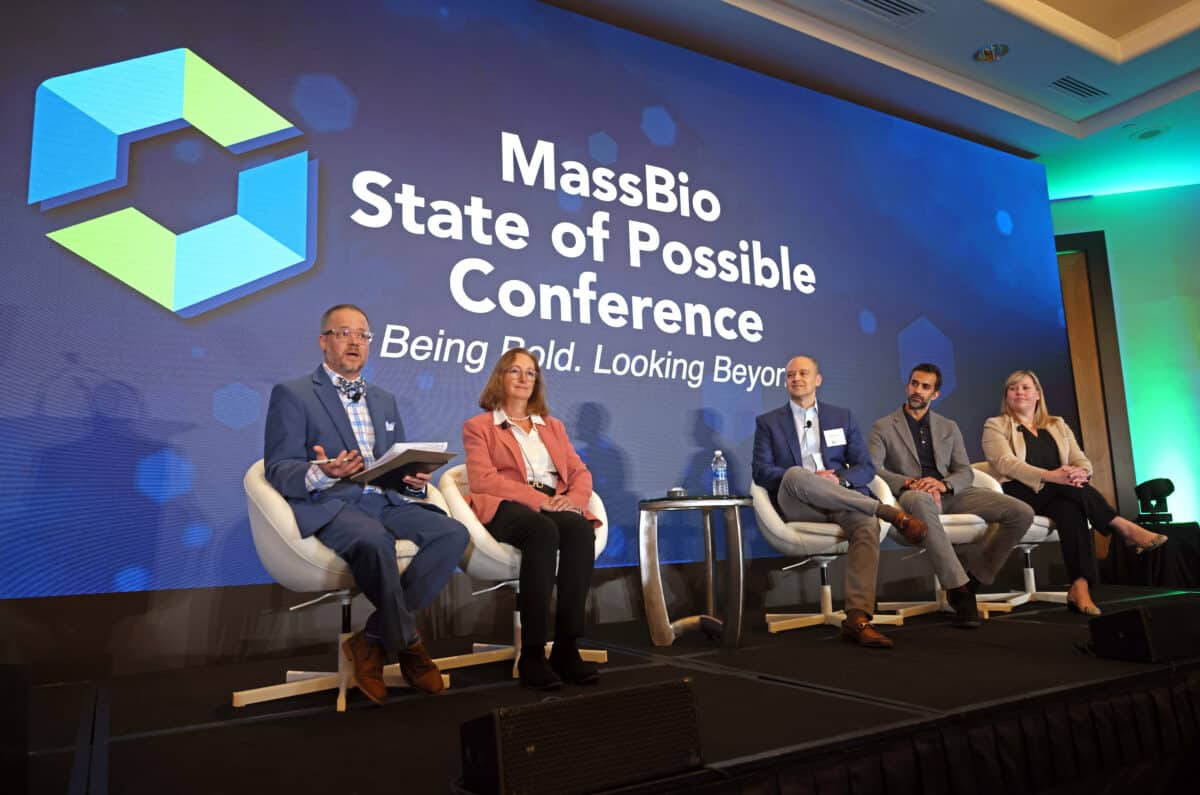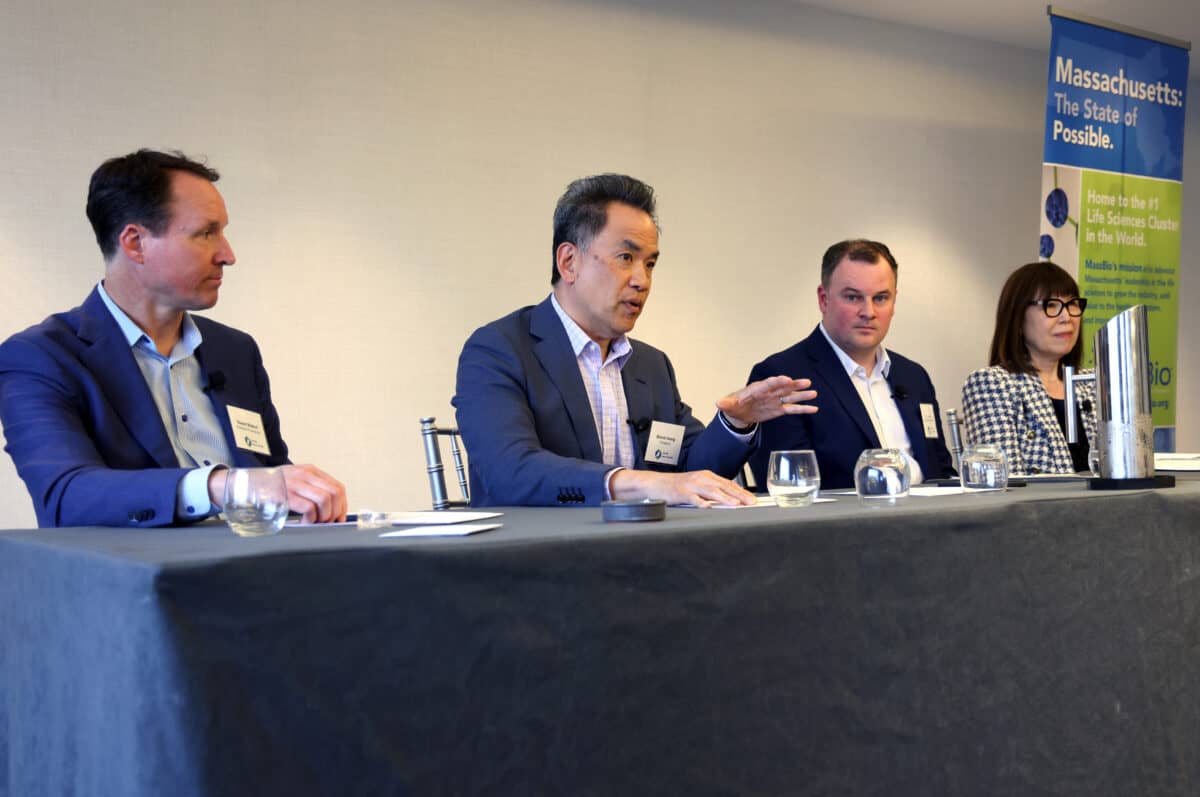
It shouldn’t surprise anyone that the annual meeting of the nation’s leading life sciences trade organization would deliver speakers who endorse the leadership status of Massachusetts’ ecosystem and sing the praises of what has been built here. To be honest, we could all use some cheerleading and backslapping these days. That said, MassBio would be derelict in our mission if the panelists didn’t also point out our flaws and barriers to growth and offer up ways for the Commonwealth to drive the industry forward, and not just in R&D and not just in Boston and Cambridge.
Connectivity to leading universities, research hospitals, and biotechs. That’s what Fiona Marshall, President of the Novartis Institutes for BioMedical Research, pointed to when she said that “every day that I go into the office I see the benefits of being in this location.”
uniQure CEO Matt Kapusta agreed, citing access to talent and resources, while Blueprint CEO Kate Haviland added the perfect match between her personal beliefs and those of the local ecosystem to the list of local perks.
After ticking off all the places around the world that he has worked and lived, stealth company CEO Rehan Verjee remarked that he’s “never experienced anything like what is happening here in Massachusetts.” Massachusetts is the best place to start a company that is invested in biomedical research and focused on creating products as a result of that research, he continued.
Prompted by moderator Doug Banks of the Boston Business Journal, each executive went a little deeper into what Massachusetts has to offer startups and established companies alike. The ease of the in-person interaction is unique to Cambridge, said Haviland: “We get data and we literally head over to Dana Farber to go talk to a world leading expert to get his view on the data.”
While the density and composition of Kendall Square is certainly the most cited reason for the state’s prominence, for some companies a more recent development has become attractive: regionalization. While business costs may be a significant factor, looking outside the urban cores of Boston and Cambridge is delivering in other ways for growing biotechs and manufacturers.
“It is a recruiting advantage to be in Lexington, and not in Kendall Square,” said Kapusta. uniQure chose the Boston suburb for the European company’s “beachhead” in the United States, one of very few licensed domestic gene therapy facilities. And that strategic decision is paying off as the company’s headcount has jumped from 30 to 250 employees.
Verjee went even further, pointing to the retention benefits of the clustering that is happening. He saw employees achieving a greater sense of community in the suburban setting, and with that belonging came a longer-term commitment to the company and its vision.
When pressed to talk challenges, the war for talent was called out, as was transportation, especially as the industry branches out beyond the urban core. But Verjee really set up the afternoon panel on biomanufacturing when he compared Massachusetts’ excellence in R&D and struggles with production and scaling to a company spending so much time acquiring a customer simply to lose them down the road.

Vivek Arora, Partner at McKinsey & Company, didn’t hold back when describing the economic benefits of a competitive biomanufacturing sector here in Massachusetts. Six-to-ten-billion-dollar contribution to GDP. One to two billion dollars in tax revenues for the state. 30,000 direct manufacturing jobs with an indirect impact on up to 80,000 additional jobs.
“The reason we are talking about biomanufacturing today is because we are lagging here in Massachusetts,” said Arora. “We have a lot of catching up to do. If we can get it right, the upside is tremendous.”
It isn’t going to be easy—one manufacturing leader on the panel pointed out that it is difficult for a place that is at the top of its game on one thing to be great in everything. But those operating in the space spoke in practical terms about some of the steps the state can take to make a serious play.
One starting point is expanding the training opportunities.
David Connolly, Director Engineering, Capacity Expansion and New Capabilities, at Rentschler Biopharma said his company had 10 participants in an existing apprenticeship program come on as full-time employees. He says getting more apprenticeship programs established with additional capacity and increasing awareness about the great career opportunities in biomanufacturing will go a long way.
With experience up and down the East Coast, Stewart McNaull of Resilience, praised BTEC, or the Biomanufacturing Training and Education Center located at NC State University in Raleigh, North Carolina, which offers excellent training regardless of experience or education level. Everything from short degree programs to advanced degrees: “When you hire someone out of BTEC, you know what you’re getting … people who understand the fundamentals, people who can think on their feet.”
McNaull, responding to a question about a concern around creating two classes of life sciences workforces, said what he sees is talented people being brought onto the manufacturing floor for a few years, working their way through additional training to enter bioprocess development labs where he says half the people in there have gone through a similar path, while the other half have PhDs.
Another significant, but less publicized barrier to major manufacturing growth is infrastructure. Dennis Huang, Chief Technical Operations Officer and Executive Vice President, Gene Therapy Research and Development at Ultragenyx, says it is very difficult to get power to a manufacturing plant. “It is a sticking point.” McNaull added the permitting is hard and time consuming.
Municipalities take note. If you can streamline your permitting—and designate a full-time local employee—and make the infrastructure and utility upgrades, you will stand out to developers.
One major selling point for Massachusetts is if biomanufacturing capacity grows, some of the hidden costs of tech transfer can be avoided, explained Ran Zheng, CEO at Landmark Bio. For early-stage companies fresh out of academia, having a partner or manufacturer that is far away risks becoming disconnected and not knowing what’s going on.
Zheng also added that state government needs to make it a priority. The reality is that the Commonwealth has begun to make a commitment here, a fact that Rehan Verjee zeroed in on during the earlier panel when he remarked that he really appreciates the tone from the top. “[The] sense of stability and sensibility here that provides a bedrock that enables you to think about mid- to long-term decisions … that’s unique here in Massachusetts,” said Verjee.
A decades long public-private partnership on life sciences R&D is a hallmark of the ecosystem that’s been built, so it’s just a natural progression for this to carry over to biomanufacturing. A new life sciences initiative is the perfect vehicle to put policies and incentives behind this goal.
If Massachusetts is to plant a flag around biomanufacturing, the cell and gene therapy space may very well be the place to do it as no one is leading there yet and it remains the “wild west.” The panelists all seemed to agree with this. “Things that are truly cutting edge, which is where Massachusetts has its strongest foothold, I think are the best place to plant those seeds,” Ultragenyx’s Huang predicted, warning that if we miss it, the state could be left with very little at the end.